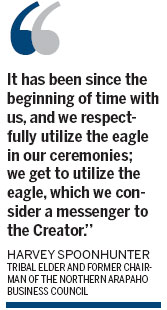Permit to kill eagles gets mixed reaction
Updated: 2012-03-20 08:48
By Ben Neary In Cheyenne, Wyoming (China Daily)
|
||||||||
|
|
A federal government decision to allow a Wyoming tribe to kill two bald eagles for a religious ceremony is a victory for American Indian sovereignty as well as for long-suppressed religious freedoms, the tribe says.
The US Fish and Wildlife Service granted a permit on March 9 to the Northern Arapaho Tribe, allowing it to either kill or capture and release two bald eagles this year.
While no one questions the religious sincerity of Northern Arapaho tribal members, spokesmen for some conservation and animal rights groups question why the tribe can't meet its religious needs without killing wild eagles. They say the tribe could raise captive birds, or accept eagle feathers or carcasses already available from a federal repository that collects birds killed by power lines or other causes.
The Northern Arapaho share the Wind River Indian Reservation in central Wyoming with the Eastern Shoshone Tribe. The Northern Arapaho decline to say specifically what they will do with the eagles the federal permit allows them to kill.
"It has been since the beginning of time with us, and we respectfully utilize the eagle in our ceremonies," said Harvey Spoonhunter, a tribal elder and former chairman of the Northern Arapaho Business Council. "We get to utilize the eagle, which we consider a messenger to the Creator."
Bald eagles were removed from the federal list of threatened species in 2007. The birds remain protected under the federal Bald and Golden Eagle Protection Act. Several Indian tribes have been allowed permits to kill golden eagles for religious purposes.
The bald eagle, which is brown with a white head and tail, has been the national bird and a symbol of the United States since the 18th century. The bald eagle is featured on most official US government seals, including the president's.
Suzan Shown Harjo, president of the Morning Star Institute, a Washington DC-based American Indian rights group, notes that only a few tribes still practice ceremonies that require them to kill eagles.
From the 1880s to the 1930s, the federal government enforced "Civilization Regulations" that criminalized traditional ceremonies, including the Northern Arapaho's Sun Dance. Many Indian religious ceremonies were stamped out, Harjo said.
"They've done the correct thing, the proper thing. It's a good step in the direction of the United States, trying to make amends for things that they did all too well to suppress Native American religious freedom for so long," Harjo said.
Andy Baldwin, lawyer for the Northern Arapaho Tribe, said the tribe went to court last fall to get the bald eagle permit following the federal prosecution of Winslow Friday, a young tribal member who shot a bald eagle on the Wind River Indian Reservation in 2005 for the Sun Dance. Friday ultimately pleaded guilty and was ordered to pay a fine in tribal court.
"One of the goals of the current suit is to prevent any young men like Winslow Friday from being prosecuted in the future for practicing their traditional religious ceremonies," Baldwin said this week.
The Fish and Wildlife Service says it issued the permit in response to the tribe's application, not the lawsuit it filed against the agency.
Federal lawyers filed a status report in the lawsuit this week, saying that the Eastern Shoshone Tribe had opposed the killing of eagles on the reservation the two tribes share. The Northern Arapaho permit specifies that the two bald eagles must be killed or captured off the reservation.
Edward Wemytewa, a member of the Zuni Tribe in western New Mexico, said he's happy for the Northern Arapaho.
"The common theme for a lot of indigenous peoples is that the bird, it brings not only strength and courage, it's just one of those creatures that still brings awe to many, many people," he said.
Associated Press

 Relief reaches isolated village
Relief reaches isolated village
 Rainfall poses new threats to quake-hit region
Rainfall poses new threats to quake-hit region
 Funerals begin for Boston bombing victims
Funerals begin for Boston bombing victims
 Quake takeaway from China's Air Force
Quake takeaway from China's Air Force
 Obama celebrates young inventors at science fair
Obama celebrates young inventors at science fair
 Earth Day marked around the world
Earth Day marked around the world
 Volunteer team helping students find sense of normalcy
Volunteer team helping students find sense of normalcy
 Ethnic groups quick to join rescue efforts
Ethnic groups quick to join rescue efforts
Most Viewed
Editor's Picks

|

|

|

|

|

|
Today's Top News
Health new priority for quake zone
Xi meets US top military officer
Japan's boats driven out of Diaoyu
China mulls online shopping legislation
Bird flu death toll rises to 22
Putin appoints new ambassador to China
Japanese ships blocked from Diaoyu Islands
Inspired by Guan, more Chinese pick up golf
US Weekly

|

|







